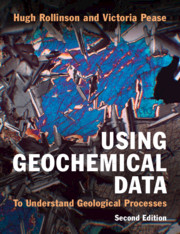Book contents
- Using Geochemical Data
- Reviews
- Using Geochemical Data
- Copyright page
- Contents
- Preface to the Second Edition
- Preface to the First Edition
- Abbreviations
- 1 Geochemical Data
- 2 Analysing Geochemical Data
- 3 Using Major Element Data
- 4 Using Trace Element Data
- 5 Using Geochemical Data to Identify Tectonic Environments
- 6 Using Radiogenic Isotope Data
- 7 Using Stable Isotope Data
- Appendices
- References
- Index
3 - Using Major Element Data
Published online by Cambridge University Press: 15 April 2021
- Using Geochemical Data
- Reviews
- Using Geochemical Data
- Copyright page
- Contents
- Preface to the Second Edition
- Preface to the First Edition
- Abbreviations
- 1 Geochemical Data
- 2 Analysing Geochemical Data
- 3 Using Major Element Data
- 4 Using Trace Element Data
- 5 Using Geochemical Data to Identify Tectonic Environments
- 6 Using Radiogenic Isotope Data
- 7 Using Stable Isotope Data
- Appendices
- References
- Index
Summary
Major element data in geochemistry are used in rock classification, in plotting variation diagrams and in plotting diagrams in which the rock chemistry is shown together with the results of experimentally determined data. The main approaches to major element rock classification in igneous and sedimentary rocks include the use of oxide–oxide plots, the calculated normative mineralogy and the rock composition recast as cations. Binary and ternary variation diagrams are widely used to display geochemical data, and a major part of the interpretation of geochemical data is the identification and the replication, through modelling, of trends on these diagrams. The wealth of experimental data on igneous rocks means that natural rock compositions may be compared with experimental data gathered at particular pressures and temperatures to understand melting and fractionation processes in the Earth’s mafic and felsic crusts and mantle.
Keywords
- Type
- Chapter
- Information
- Using Geochemical DataTo Understand Geological Processes, pp. 49 - 95Publisher: Cambridge University PressPrint publication year: 2021
- 2
- Cited by

